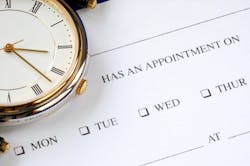Every time a patient doesn’t show up for a scheduled appointment, it sends your entire practice into chaos. Your team goes into panic mode as your scheduling coordinator scrambles to find someone to take the open slot.
Yes, it can be stressful when patients flake out on their appointment times, but it can also be costly. Cancellations and no-shows cost practices tens of thousands of dollars in lost revenue every year. Don’t believe me? Let me give you an example. If your practice averages two cancellations/no-shows a day, at a value of about $100 to $125 each, you’re losing more than $40,000 a year. If that number wasn’t bad enough, it doesn’t even include the thousands of dollars in lost production you never had the chance to diagnose.
If you want to have a successful, thriving dental practice, you have to reduce the number of cancellations and no-shows that leave your schedule with gaping holes, making it very difficult for you to meet production numbers. You’ll never eliminate cancellations and no-shows entirely, but if you follow these tips you’ll significantly reduce them. And that, doctor, will boost your production numbers and your bottom line.
ALSO BY SALLY MCKENZIE:How to avoid these 6 common hiring mistakes in your dental practice
6 reasons dental patients say ‘no’ to treatment, and how you can change that
Dental staff not getting along? Here's what it's doing to your practice
Don’t rely on pre-appointing alone—Chances are, your patients have no idea what they’re doing on a Tuesday morning six months from now. So if you schedule patients that far out, you can almost bet something will come up that keeps them from keeping their appointment.
Instead of relying solely on pre-appointing, consider implementing a hybrid system. Only pre-appoint reliable patients, and flag any patients who have at least two no-shows as unreliable. Call these patients as appointment times come up rather than scheduling them months in advance.
Be thorough—When a patient schedules an appointment, be sure to go over every detail with that patient before he or she leaves your practice. Here’s an example: “Mr. Williams, your one-hour appointment is scheduled for Wednesday, October 12 at 1 p.m. If you can’t keep this appointment for any reason, please call our office at least 48 hours in advance to allow another patient the opportunity to see Dr. Smith at that time.”
Always confirm appointments—Train your scheduling coordinator to confirm appointments two days in advance. Ask patients for their preferred method of contact, whether phone call, email, or text message. If a patient prefers a phone call, make sure your coordinator knows leaving a voicemail isn’t enough—she has to actually talk to the patient to confirm the appointment. I also recommend scheduling time to confirm appointments after hours. This ensures you reach patients who are busy during the day.
Develop a policy—If you don’t have one already, now is a great time to create a broken appointment policy, and communicate that policy with both new and existing patients. If patients know your practice has a broken appointment policy, they’ll be less likely to flake out. Remind patients of your policy every time they make an appointment.
Cancellations and no-shows not only lead to stress, they also cost the practice money. If you follow these tips, more patients will show up for their appointment times, boosting your production numbers and growing your bottom line.








